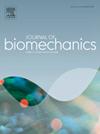Convex wrapping description of biarticular hip muscles for patient-specific musculoskeletal modeling
IF 2.4
3区 医学
Q3 BIOPHYSICS
引用次数: 0
Abstract
Determination of hip muscle paths and their moment arms is crucial in subject-specific musculoskeletal modeling. Existing approaches, including via-point, obstacle-set, and others, cannot estimate a smooth path for biarticular muscles such as iliopsoas. This study proposed a modified convex wrapping algorithm based on subject-specific medical imaging to prevent the predicted path from penetrating its underlying bone geometries. Muscle attachment points were automatically personalized using the point cloud registration method. The muscle path was then defined as the shortest path wrapped over the convex hull and searched via Dijkstra’s algorithm. Moreover, a constraint plane for preventing muscle–bone penetration was obtained using the point cloud of the underlying bone. The results of the identified iliopsoas path were compared with the conventional via-point method, revealing that the proposed algorithm can overcome the shortcoming of path non-smoothness via-point paths with certain hip postures. The obtained moment arms were further validated using the magnetic-resonance-imaging-based measurement from the literature, corroborating its applications in musculoskeletal modeling and quantitative surgical planning.
双关节髋部肌肉的凸包膜描述用于患者特定的肌肉骨骼建模
髋部肌肉路径及其力臂的确定在受试者特定的肌肉骨骼模型中至关重要。现有的方法,包括通过点、障碍设置等,不能估计髂腰肌等双关节肌肉的平滑路径。本研究提出了一种改进的基于受试者特异性医学成像的凸包裹算法,以防止预测路径穿透其底层骨骼几何形状。采用点云配准方法对肌肉附着点进行自动个性化。然后将肌肉路径定义为包裹在凸包上的最短路径,并通过Dijkstra算法进行搜索。利用下位骨的点云,得到了防止骨骼肌穿透的约束平面。将识别出的髂腰肌路径与传统的过点法进行了比较,结果表明该算法克服了特定髋关节姿态下的过点法路径不光滑的缺点。利用文献中基于磁共振成像的测量进一步验证了获得的力矩臂,证实了其在肌肉骨骼建模和定量手术计划中的应用。
本文章由计算机程序翻译,如有差异,请以英文原文为准。
求助全文
约1分钟内获得全文
求助全文
来源期刊

Journal of biomechanics
生物-工程:生物医学
CiteScore
5.10
自引率
4.20%
发文量
345
审稿时长
1 months
期刊介绍:
The Journal of Biomechanics publishes reports of original and substantial findings using the principles of mechanics to explore biological problems. Analytical, as well as experimental papers may be submitted, and the journal accepts original articles, surveys and perspective articles (usually by Editorial invitation only), book reviews and letters to the Editor. The criteria for acceptance of manuscripts include excellence, novelty, significance, clarity, conciseness and interest to the readership.
Papers published in the journal may cover a wide range of topics in biomechanics, including, but not limited to:
-Fundamental Topics - Biomechanics of the musculoskeletal, cardiovascular, and respiratory systems, mechanics of hard and soft tissues, biofluid mechanics, mechanics of prostheses and implant-tissue interfaces, mechanics of cells.
-Cardiovascular and Respiratory Biomechanics - Mechanics of blood-flow, air-flow, mechanics of the soft tissues, flow-tissue or flow-prosthesis interactions.
-Cell Biomechanics - Biomechanic analyses of cells, membranes and sub-cellular structures; the relationship of the mechanical environment to cell and tissue response.
-Dental Biomechanics - Design and analysis of dental tissues and prostheses, mechanics of chewing.
-Functional Tissue Engineering - The role of biomechanical factors in engineered tissue replacements and regenerative medicine.
-Injury Biomechanics - Mechanics of impact and trauma, dynamics of man-machine interaction.
-Molecular Biomechanics - Mechanical analyses of biomolecules.
-Orthopedic Biomechanics - Mechanics of fracture and fracture fixation, mechanics of implants and implant fixation, mechanics of bones and joints, wear of natural and artificial joints.
-Rehabilitation Biomechanics - Analyses of gait, mechanics of prosthetics and orthotics.
-Sports Biomechanics - Mechanical analyses of sports performance.
 求助内容:
求助内容: 应助结果提醒方式:
应助结果提醒方式:


